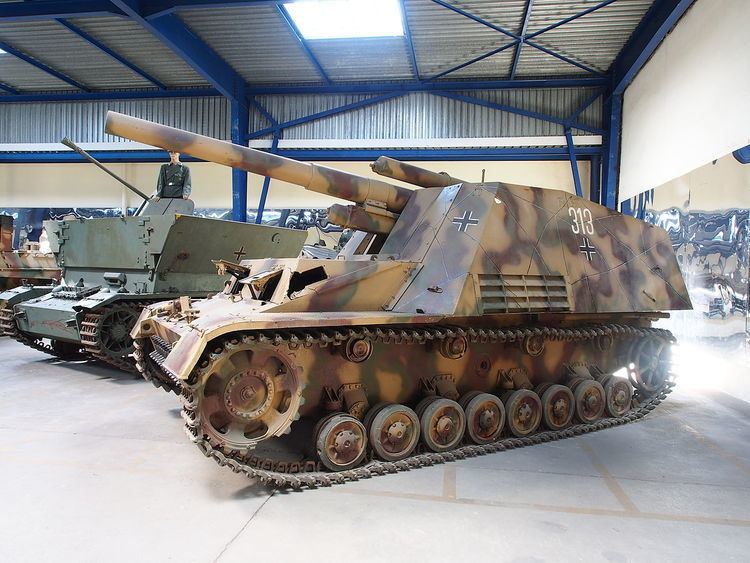Weight 24 tonnes (52,910 lb) | In service 1943–1945 No. built 714 | |
 | ||
Hummel (German: "bumblebee") was a self-propelled artillery gun based on the Geschützwagen III/IV chassis and armed with a 15 cm howitzer. It was used by the German Wehrmacht during the Second World War from early 1943 until the end of the war.
Contents
The full name was Panzerfeldhaubitze 18M auf Geschützwagen III/IV (Sf) Hummel, Sd.Kfz. 165. On February 27, 1944, Hitler ordered the name Hummel to be dropped as it was deemed inappropriate for a fighting vehicle.
Development
The Hummel was designed in 1942 out of a need for mobile artillery support for the tank forces, the lack of which had first been felt during the invasion of the USSR. There were some self-propelled artillery vehicles already in service with the Wehrmacht at the time, but most were of limited value.
The first option looked at was mounting a 10.5 cm leFH 18 howitzer on a Panzer III chassis, but this was rejected in favour of the same howitzer on a Panzer IV chassis. One prototype was built of this design.
This design was again rejected, this time in favour of a more powerful solution: mounting the 15 cm sFH 18 L/30 howitzer on the specially designed Geschützwagen III/IV, which took elements of both the Panzer III (driving and steering system) and Panzer IV chassis (suspension and engine). The same chassis was also used for the Nashorn tank destroyer.
The Hummel had an open-topped lightly armoured fighting compartment at the back of the vehicle, which housed the howitzer and the crew. The engine was moved to the centre of the vehicle to make room for this compartment. Late model Hummels had a slightly redesigned driver compartment and front superstructure, to offer more room to the radio operator and driver.
Variants
Because the basic Hummel could carry only a limited amount of ammunition, the Munitionsträger Hummel ("ammunition carrier Hummel") was developed. This was basically a standard production Hummel without the howitzer (a 10 mm armour plate covering the gun mount) and with racks fitted to hold the ammunition. When necessary, these could still be fitted with the 15 cm howitzer of the normal Hummel; this could even be done as a field conversion.
By the end of the war, 714 Hummel had been built together with 150 ammunition carriers using the same design.
Combat history
The Hummel first participated in large scale combat at the Battle of Kursk, when some 100 Hummel were in service. They served in armored artillery battalions (Panzerartillerie Abteilungen) of the Panzer divisions, forming separate heavy self-propelled artillery batteries, each with six Hummel and one ammunition carrier.
Foreign use
Romania received one unit from the Red Army after the war ended. This was assigned to the 2nd Armoured Regiment with the registration number U069009. It was officially known as the Hummel TAs self-propelled gun in the army inventory. The gun couldn't be used because it was missing the lock. It was shown to the public on the 10th of May Bucharest parade in 1946 with Romanian markings.
All German armour units in Romania had been scrapped by 1954.
Surviving vehicles
Five Hummel survive in museums, at the Munster Deutsches Panzermuseum, the Wehrtechnische Studiensammlung in Koblenz and the Sinsheim Auto & Technik Museum in Germany, the Musée des Blindés in Saumur, France and the Fort Sill Field Artillery Museum in Fort Sill, Oklahoma.
